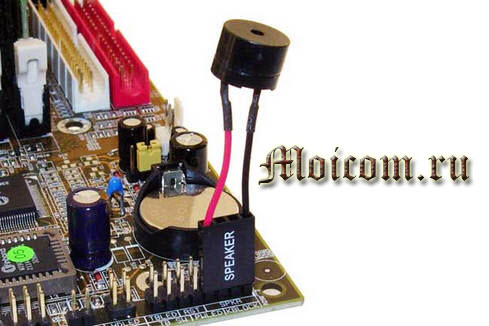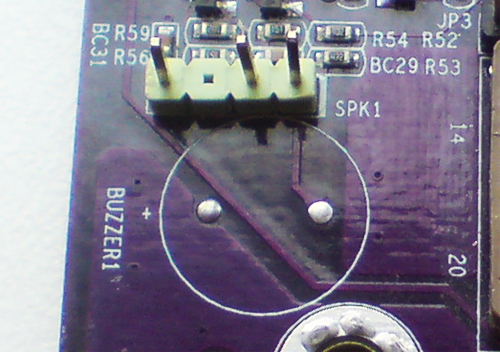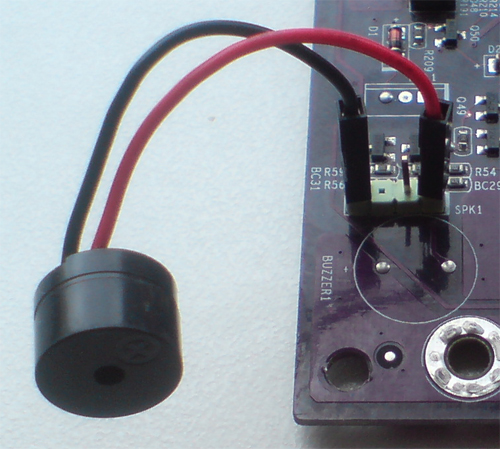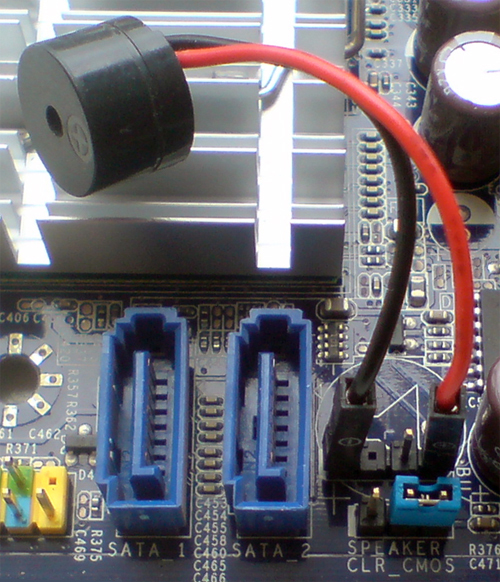Sections of the site
Editor's Choice:
- How to install Windows on Mac?
- Asus rt n16 setup firmware
- How to find out the bitness of the operating system and processor in Windows
- How to turn off the Windows Firewall: complete deactivation and disabling for individual programs How to completely disable the Windows 7 firewall
- Powerful converter of HTML files to Doc, PDF, Excel, JPEG, Text Using the Total HTML Converter program
- How to remove headers and footers in Excel How to make a header and footers in Excel
- Design and principle of operation
- Create a portrait from a font using Photoshop Portraits from letters
- History of the device
- How to reinstall a program on your computer How to reinstall a game without deleting it
Advertising
| Where to connect the speaker to the motherboard. External sound speaker - signaling device |
|
In this article we will talk about the speaker and the BIOS signals that it emits when you turn on the computer. Today you will learn what computer alarm sounds are, what they mean and how to understand them. In the previous publication we talked about (safe mode). Computer voiceSound signals when the computer is turned on are produced by a small speaker called Speaker. It is located inside your system unit which is connected to motherboard computer. When the computer starts, it notifies the user about the general performance of the system unit. When you turn on the computer, the speaker emits one to several BIOS signals. If there is only one signal, then everything is fine. If there are more signals or they are repeated within a certain interval, then something is broken or out of order. You can read more about what this is here. Brief description of sound signals:No signals at all– most likely there is no power to the motherboard (the power supply may have burned out), or less often, the motherboard itself has burned out.
One long or repeated– complains about random access memory (RAM), least often CPU(CPU). You need to remove and reinsert the RAM into the slots. There is another precise characteristic and description of the speaker signals, which we will not consider in this article. It usually describes rare signals that occur very rarely. The following example is also possible. Your computer turns on and boots normally, but no signal(s) can be heard.
In this case, you most likely did not install the Speaker on the motherboard of your computer. In custodyToday we learned what BIOS signals are, what a Speaker is, why it is needed and what role it plays in our computer. Perhaps you have questions related to BIOS signals. You can ask them below in the comments to this article, and also use the form with me. Thank you for reading me on When you turn on the computer, a series of tests of the hardware components of the system is launched. The fact that all tests were successful is indicated by one short signal system dynamics. If something goes wrong and the test does not pass, the nature of the malfunction is also signaled by the speaker with a series of sound signals. The nature of the signals depends on the motherboard BIOS manufacturer. Tables of beep sounds for different basic I/O systems are provided in the article "BIOS beep sounds". When the speaker is soldered into the motherboard, the sound signal will sound in any case - it will be either one short signal (everything is in order), or a series of signals (the test failed). If the speaker is not connected to the motherboard, or is connected incorrectly, or is missing altogether, then in case of problems with starting the computer, information about the nature of the malfunction in the form of sound signals simply will not be heard. After all, it may turn out that the repairman does not understand why the system does not start, the repairman puzzles over the problem, although you can give the motherboard the opportunity to “tell” about its problems - just connect a speaker to it. A signal is sent to the speaker connector, but if there is no speaker, the technician, unfortunately, will not hear the prompt signal. In short, if the computer does not start, you need to check whether there is a speaker on the motherboard, whether it is connected to it with wires (and whether it is correct). The system may stubbornly refuse to start, and repairs may go as far as removing the motherboard from the system case and working with it on the repairman’s bench. In this case, the main thing is not to miss important sound signals from the speaker. If the speaker is not soldered into the motherboard, then it is not necessary to drag it to the one lying on the table system board speaker wires located in the computer case. It is very convenient to connect such a small speaker to the motherboard with wires (observing the polarity): The main thing is to find the speaker connector on the motherboard. As a rule, this connector is located on a common terminal block among other pins. It is a group of four pins, the signal is taken from the two outermost ones. Connector identifier - "Speaker", "Buzzer" or "SPK":
We connect a speaker-speaker to the connector. If there are no speaker polarity markings on the board, try connecting them in reverse polarity positions. In this case it worked the first time:
The connector can be located separately from the general group:
It’s even easier to connect it:
The speaker connector can also be found by the icon depicting a speaker:
Speaker-signaler installed:
When assembling a computer, don’t forget to connect the speaker to the system board of the device! Send your feedback about the article to the administrator: Besides sound card, the computer has a control unit for the built-in speaker. The speaker itself, however, is often forgotten to be connected when assembling the car. It may be needed when running old programs, as well as when diagnosing the machine. InstructionsCarefully inspect the motherboard. Perhaps it already has a miniature loudspeaker. It has approximately the same diameter as a penny coin and comes in a black casing. If you can't find it, try starting the machine without attaching an external speaker to the motherboard. If you have this type of speaker, you will hear a single tone during the Power-On Self-Test (POST). If you find that there is no built-in speaker on your motherboard, first try to find a large speaker in your computer case. Sometimes it is not visible because it is hidden between the metal front wall of the case and the plastic false panel. But in any case, a two-wire cable with a connector at the end is attached to it. This connector is usually labeled Speaker. It also happens that the connectors are not labeled in any way. In this case, find a cable with a wide four-pin connector that is not connected to the motherboard. The wires should only fit to its first and last contacts, and the middle ones should not be connected anywhere, or may be completely absent. Take a regular 1.5 V battery. Insert a pin into the first and last sockets of the connector and connect them to the battery. If you hear clicking noises when connecting and disconnecting, then this is the speaker connector. Do not touch the contacts in order to avoid being shocked by self-inductive voltage (the speaker is an inductive element). Then remove the pins. Locate the pin combination on the motherboard labeled Speaker or SPKR. There should also be four of them. Connect the speaker connector to them (with the car de-energized) in any polarity. Start your computer and check that the speaker is working properly during POST. Launch any program that uses it. Attention, TODAY only! Everything interesting These days it's hard to find a computer without a sound card. However, the built-in speaker connected to the motherboard still needs to be remembered to connect to it. It will make it possible to hear BIOS error codes, as well as beeps... To supply power to the motherboard, you need to know what type of unit is suitable for it. There are only two options: AT or ATX power supplies. More powerful motherboards require an additional connector to the processor. Instructions1 Turn off the power... If your hard drive runs out of free memory, the problem can be easily fixed by purchasing and installing a new hard drive. Quite often many users to connect or replace hard drive take your system unit to the service center... If you have not yet purchased a separate sound card or do not have Personal Computer, and a laptop, you may need to connect sound from the sound card built into the motherboard. Modern motherboards have such built-in... When assembling a computer, you most likely turned on the PC by bridging the corresponding contacts on the motherboard with a screwdriver. This is relatively convenient only at the assembly stage. It is clear that in everyday work no one should do this when the case is closed... Hard drives and CD-ROM drives with IDE connectors are now available in much smaller quantities than before. It is difficult to find a place to place such devices in new system units. However, you can still find... If you purchased new hard disk or you need to connect a third-party hard drive to your computer, this is not difficult to do. Depending on the type of connection of the hard drive, you may need power cables and a cable to connect to... The presence of USB ports on the front panel of the system unit is a very convenient solution. Usually these ports are connected, but in some cases - for example, when assembling a new computer from components - you have to connect these ports yourself. ... There may be some difficulties when connecting headphones to the motherboard. Let us analyze the sequence of actions that will allow you to successfully complete the task. Instructions1Take headphones with a mini-jack connector and connect them to... |
Popular:
How to find out the VID, PID of a flash drive and what are these identification numbers used for?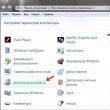
|
New
- Asus rt n16 setup firmware
- How to find out the bitness of the operating system and processor in Windows
- How to turn off the Windows Firewall: complete deactivation and disabling for individual programs How to completely disable the Windows 7 firewall
- Powerful converter of HTML files to Doc, PDF, Excel, JPEG, Text Using the Total HTML Converter program
- How to remove headers and footers in Excel How to make a header and footers in Excel
- Design and principle of operation
- Create a portrait from a font using Photoshop Portraits from letters
- History of the device
- How to reinstall a program on your computer How to reinstall a game without deleting it
- Selfish profile php mode


